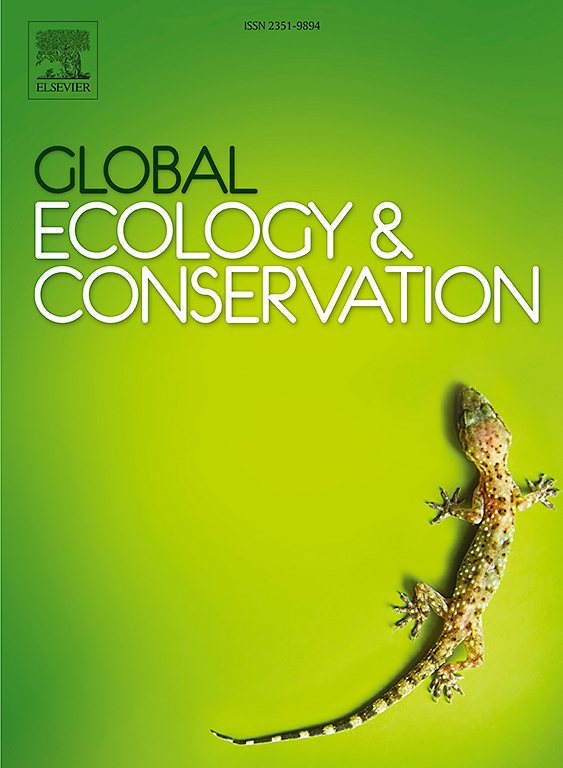Biomod2 for evaluating the changes in the spatiotemporal distribution of Locusta migratoria tibetensis Chen in the Qinghai-Tibet Plateau under climate change
IF 3.5
2区 环境科学与生态学
Q1 BIODIVERSITY CONSERVATION
引用次数: 0
Abstract
[Objective] The present study endeavors to elucidate the impact of climate change on the distribution of Locusta migratoria tibetensis Chen and to furnish theoretical underpinnings for the forecasting and management of this pest. [Method] Utilizing 68 geographical distribution points of L. migratoria tibetensis, in conjunction with 6 environmental variables, a composite model was developed employing the Biomod2 software package to simulate potential shifts in the spatial distribution of L. migratoria tibetensis under future climate scenarios. [Result] The current highly inhabitable region of L. migratoria tibetensis was predominantly located in the eastern and southern sectors of the Qinghai-Tibet Plateau, encompassing an area of 8.27 × 104 km2. The inhabitable region was the most widely distributed under SSP5–8.5 in the 2050 s, with an expanded area reaching 42.96 × 104 km2, and contiguous distributed in the western and northern parts of the Qinghai Tibet Plateau. The centroid of the highly and total inhabitable regions would migrate northwest under most scenarios. The main environmental variables affecting the distribution of L. migratoria tibetensis were altitude, the mean temperature of coldest quarter and the precipitation of warmest quarter. The ensemble model constructed by integrating the five optimal individual models demonstrated superior predictive performance, as evidenced by an area under the receiver operating characteristic curve of 0.918 and a true skill statistics value 0.752. [Conclusion] The spatial distribution pattern of L. migratoria tibetensis was predominantly influenced by altitude, with hydrological and thermal conditions also playing significant roles. Under future climate conditions, the highly inhabitable region of L. migratoria tibetensis was expected to increment, with the exception of scenarios under SSP2.6 and SSP5–8.5 in the 2090 s. Conversely, the moderately inhabitable region was anticipated to expand under all climate scenarios. Our findings indicated that climate warming could be advantageous for the survival of L. migratoria tibetensis, necessitating vigilant monitoring and the implementation of targeted prevention strategies.
气候变化下青藏高原西藏飞蝗时空分布变化的Biomod2评价
[目的]研究气候变化对西藏飞蝗分布的影响,为该害虫的预测和管理提供理论依据。[方法]利用68个西藏迁徙l.a地理分布点,结合6个环境变量,利用Biomod2软件包建立复合模型,模拟未来气候情景下西藏迁徙l.a空间分布的潜在变化。[结果]青藏高原东段和南段是目前藏羚羊高度宜居区,面积为8.27 × 104 km2。2050年 s SSP5-8.5下可居住区域分布最广,扩展面积达42.96 × 104 km2,在青藏高原西部和北部连续分布。在大多数情况下,高度和全部可居住区域的重心将向西北迁移。海拔高度、最冷季平均气温和最暖季降水是影响西藏飞蝗分布的主要环境因子。综合5个最优个体模型构建的集成模型预测效果较好,受者工作特征曲线下面积为0.918,真技能统计值为0.752。[结论]青藏高原L. migratoria tibetan的空间分布格局主要受海拔的影响,水文和热条件也起着重要作用。在未来气候条件下,除SSP2.6和SSP5-8.5情景外,预计2090年代 s青藏高原高宜居区面积将增加。相反,预计在所有气候情景下,中等宜居区域都将扩大。研究结果表明,气候变暖可能有利于西藏迁徙l.a的生存,有必要进行警惕监测和实施有针对性的预防策略。
本文章由计算机程序翻译,如有差异,请以英文原文为准。
求助全文
约1分钟内获得全文
求助全文
来源期刊

Global Ecology and Conservation
Agricultural and Biological Sciences-Ecology, Evolution, Behavior and Systematics
CiteScore
8.10
自引率
5.00%
发文量
346
审稿时长
83 days
期刊介绍:
Global Ecology and Conservation is a peer-reviewed, open-access journal covering all sub-disciplines of ecological and conservation science: from theory to practice, from molecules to ecosystems, from regional to global. The fields covered include: organismal, population, community, and ecosystem ecology; physiological, evolutionary, and behavioral ecology; and conservation science.
 求助内容:
求助内容: 应助结果提醒方式:
应助结果提醒方式:


